Race Surname Ancestry ResultsOur indexes 1000-1999 include entries for the spelling 'race'. In the period you have requested, we have the following 174 records (displaying 71 to 80): Single Surname Subscription | | | Buying all 174 results of this search individually would cost £972.00. But you can have free access to all 174 records for a year, to view, to save and print, for £100. Save £872.00. More... |
These sample scans are from the original record. You will get scans of the full pages or articles where the surname you searched for has been found. Your web browser may prevent the sample windows from opening; in this case please change your browser settings to allow pop-up windows from this site. Prosecutions in County Durham: Prisoners
(1844)
The accounts of the Treasurer of County Durham include among the disbursements the cost of prosecutions: giving when paid, attorney's name, prisoner's full name, term when prosecuted, and cost. The term of prosecution is identified by the abbreviations 1 S. for Epiphany Sessions; 2 S., Easter Sessions; 3 S., Midsummer Sessions; 4 S., Michaelmas Sessions; Ad. S., Adjourned Sessions; Sp. A., Spring Assizes; S. A., Summer Assizes; W. A., Winter Assizes. 1 January to 28 December 1844. The total cost of prosecutions for the year was £4,057 16s 7d.RACE. Cost: £6.00.  | Sample scan, click to enlarge

| Masters of English Merchantmen at Antwerp (1845)
The custom house at Antwerp issued daily reports of ships entering (aenkomsten) and departing (vertrekken) the harbour. For entrances the information recorded is the precise date, the nationality of the ship (eng./engelsch=English/British), the type of ship (bark=barque, brik=brig, goelet=galliot; jagt=yacht, stoomboot=steamer), the surname of the captain (k./kap.), whence, and brief note of the cargo. The departure information is much the same, but usually stating only whether in ballast or with a cargo (met lading). English ships formed a large part of the traffic, and almost all the steamers plying between Antwerp and London or Hull were registered in England. The reports, published in the newspaper Het Handelsblad der Stad en Provincie Antwerpen, and presumably based on handwritten originals, show a wide variation in spelling of the English names of both ships and masters.
RACE. Cost: £8.00.  | Sample scan, click to enlarge
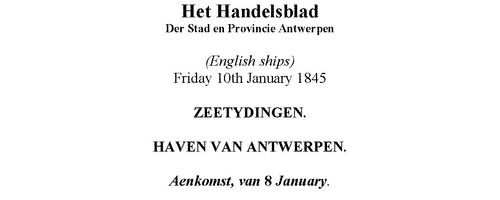
| Prisoners in County Durham
(1845)
A total of £2272 11d was disbursed by the County Treasurer of Durham from 31 December 1844 to 25 August 1845 to attorneys conducting prosecutions in the county sessions and assizes. The accounts list date of payment; attorney's surname; full name of prisoner; when prosecuted; and cost. The abbreviations used are 1 S. for Epiphany Sessions; 2 S., Easter Sessions; 3 S., Midsummer Sessions; 4 S., Michaelmas Sessions; Spl. S., Special Sessions; Sp. A., Spring Assizes; S. A., Summer Assizes; W. A., Winter Assizes. On page 214 the year is wrongly given as 1844.RACE. Cost: £6.00.  | Sample scan, click to enlarge

| Railway Subscription Contracts
(1845)
£21,386,703 6s 4d was promised by about 10,000 subscribers of less than £2,000 per contract to the nearly 200 railway bills deposited in the Private Bill Office during the Session of Parliament for 1845. This alphabetical list gives the full names of the subscribers (surname first), description (i. e., occupation), place of abode, a numerical reference to the title of the railway, the amount subscribed to each, and total. There is a separate key to the titles of the railways.RACE. Cost: £4.00.  | Sample scan, click to enlarge

| Electors for Barnsley
(1848)
On 14 and 15 December 1848 an election took place for a Knight of the Shire for the West Riding of Yorkshire in the House of Commons. The candidates were Edmund Denison and sir Culling Eardley Eardley, gaining 14,743 and 11,795 votes respectively. The county franchise at this period included freeholders of land worth 40s or more a year; £10 copyholders and long-leaseholders; and £50 short-leaseholders and tenants. This poll book was published in 1849.
Former poll books had been compiled from the sheriff's returns; but as these were now transmitted to the Home Office immediately after an election, in this instance the polling was marked from the check-clerk's returns, carefully compared with the registers marked in the poll booths at the time of voting.
The votes for the respective candidates are indicated by the numerals 1 (Denison) and 2 (Eardley). The omission of these numerals indicates that the elector did not vote. Many names which appear on the register of particular townships are completely omitted in this poll book: in all these cases, the same name will be found recorded in some other township, the elector having two or more qualifications. In such cases, his name only appears in the poll book in the actual township for which he chose to vote; or, if he did not vote at all, in that township for which he was qualified that lay closest to his actual residence.
The townships are arranged alphabetically within polling district; and within each township the names are arranged alphabetically by surname and christian name, and the elector's residence is given. Many of the electors resided outside the township for which they were qualified - some in other counties. Moreover, at the end of each polling district there is a list of persons registered to poll in that district, from townships is other districts. RACE. Cost: £4.00.  | Sample scan, click to enlarge
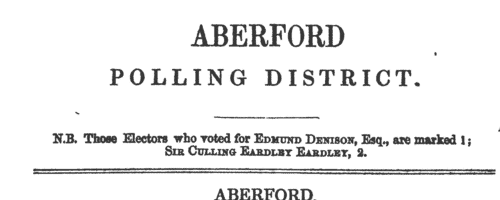
| Electors for Crigglestone
(1848)
On 14 and 15 December 1848 an election took place for a Knight of the Shire for the West Riding of Yorkshire in the House of Commons. The candidates were Edmund Denison and sir Culling Eardley Eardley, gaining 14,743 and 11,795 votes respectively. The county franchise at this period included freeholders of land worth 40s or more a year; £10 copyholders and long-leaseholders; and £50 short-leaseholders and tenants. This poll book was published in 1849.
Former poll books had been compiled from the sheriff's returns; but as these were now transmitted to the Home Office immediately after an election, in this instance the polling was marked from the check-clerk's returns, carefully compared with the registers marked in the poll booths at the time of voting.
The votes for the respective candidates are indicated by the numerals 1 (Denison) and 2 (Eardley). The omission of these numerals indicates that the elector did not vote. Many names which appear on the register of particular townships are completely omitted in this poll book: in all these cases, the same name will be found recorded in some other township, the elector having two or more qualifications. In such cases, his name only appears in the poll book in the actual township for which he chose to vote; or, if he did not vote at all, in that township for which he was qualified that lay closest to his actual residence.
The townships are arranged alphabetically within polling district; and within each township the names are arranged alphabetically by surname and christian name, and the elector's residence is given. Many of the electors resided outside the township for which they were qualified - some in other counties. Moreover, at the end of each polling district there is a list of persons registered to poll in that district, from townships is other districts. RACE. Cost: £6.00.  | Sample scan, click to enlarge
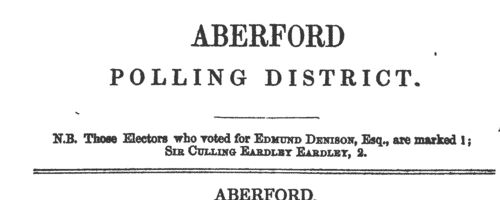
| Electors for Horbury
(1848)
On 14 and 15 December 1848 an election took place for a Knight of the Shire for the West Riding of Yorkshire in the House of Commons. The candidates were Edmund Denison and sir Culling Eardley Eardley, gaining 14,743 and 11,795 votes respectively. The county franchise at this period included freeholders of land worth 40s or more a year; £10 copyholders and long-leaseholders; and £50 short-leaseholders and tenants. This poll book was published in 1849.
Former poll books had been compiled from the sheriff's returns; but as these were now transmitted to the Home Office immediately after an election, in this instance the polling was marked from the check-clerk's returns, carefully compared with the registers marked in the poll booths at the time of voting.
The votes for the respective candidates are indicated by the numerals 1 (Denison) and 2 (Eardley). The omission of these numerals indicates that the elector did not vote. Many names which appear on the register of particular townships are completely omitted in this poll book: in all these cases, the same name will be found recorded in some other township, the elector having two or more qualifications. In such cases, his name only appears in the poll book in the actual township for which he chose to vote; or, if he did not vote at all, in that township for which he was qualified that lay closest to his actual residence.
The townships are arranged alphabetically within polling district; and within each township the names are arranged alphabetically by surname and christian name, and the elector's residence is given. Many of the electors resided outside the township for which they were qualified - some in other counties. Moreover, at the end of each polling district there is a list of persons registered to poll in that district, from townships is other districts. RACE. Cost: £6.00.  | Sample scan, click to enlarge
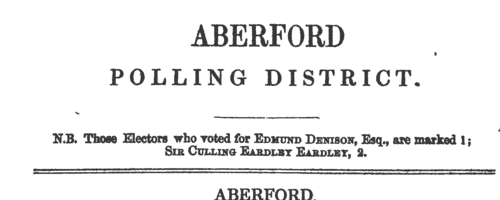
| Electors for Kexbrough
(1848)
On 14 and 15 December 1848 an election took place for a Knight of the Shire for the West Riding of Yorkshire in the House of Commons. The candidates were Edmund Denison and sir Culling Eardley Eardley, gaining 14,743 and 11,795 votes respectively. The county franchise at this period included freeholders of land worth 40s or more a year; £10 copyholders and long-leaseholders; and £50 short-leaseholders and tenants. This poll book was published in 1849.
Former poll books had been compiled from the sheriff's returns; but as these were now transmitted to the Home Office immediately after an election, in this instance the polling was marked from the check-clerk's returns, carefully compared with the registers marked in the poll booths at the time of voting.
The votes for the respective candidates are indicated by the numerals 1 (Denison) and 2 (Eardley). The omission of these numerals indicates that the elector did not vote. Many names which appear on the register of particular townships are completely omitted in this poll book: in all these cases, the same name will be found recorded in some other township, the elector having two or more qualifications. In such cases, his name only appears in the poll book in the actual township for which he chose to vote; or, if he did not vote at all, in that township for which he was qualified that lay closest to his actual residence.
The townships are arranged alphabetically within polling district; and within each township the names are arranged alphabetically by surname and christian name, and the elector's residence is given. Many of the electors resided outside the township for which they were qualified - some in other counties. Moreover, at the end of each polling district there is a list of persons registered to poll in that district, from townships is other districts. RACE. Cost: £6.00.  | Sample scan, click to enlarge
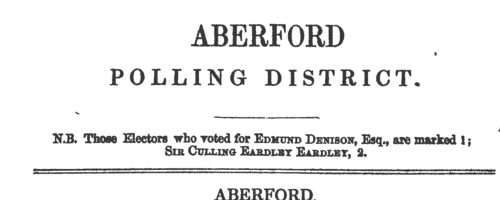
| Hertfordshire Sessions
(1699-1850)
Incidents from the Hertfordshire Sessions Rolls. These cover a wide range of criminal and civil business for the county, with presentments, petitions, and recognizances to appear as witnesses: many of the records concern the county authorities dealing with regulation of alehouses, religious conventicles, absence from church, highways, poaching, profanation of the Sabbath, exercising trades without due apprenticeship &c. Unlike the Sessions Books, the decisions of the justices are not recorded on the rolls, which serve more as a record of evidence and allegations. This is a calendar of abstracts of extracts: it is by no means a completely comprehensive record of the surviving Hertfordshire sessions rolls of the period, but coverage is good. RACE. Cost: £4.00.  | Sample scan, click to enlarge
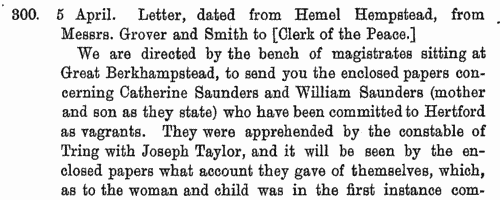
|  Inhabitants of Newington in Surrey
(1851) Inhabitants of Newington in Surrey
(1851)
The 1851 census return for St Mary Newington, Surrey, registration district: St Peter Walworth sub-district: enumeration district 14: described as: "All that Part of the Parish of St. Mary Newington, which Comprises The East side of Portland St. from Clandon St. to Trafalgar St, South side of Trafalgar St. from Portland St. to South St., & West side of South St. from Trafalgar St. to Clandon St., Including Burton St. (both sides), Ewhurst St. (both sides) from Clandon St. to the end, Ewhurst Court, Webb St. (both sides), Hope St., Dykes Cottages, Thornton Place, Ebenezer St. (both sides) & Elizabeth Place". This area lay in the ecclesiastical district of St Peter Walworth, and in the borough of Lambeth. HO 107/1567. The addresses listed in the actual returns are 1 to 6 Gloster Place, Portland Street; 1 to 5 and 101 to 108 Portland Street; 1 to 15 and 20 to 24 Burton Street; 1 to 16 Webb Street; 1 to 7 and 51 to 58 Ewhurst Street; 1 to 7 Ewhurst Place; 1 to 7 and 12 Hope Street (including Hope Cottage); 1 to 41 Trafalgar Street (including brewery); 1 and 2 Dykes Cottages; 1 and 2 Thornton Street; 1 to 7 South Street (including Queen Anne beerhouse); 1 to 4 Thornton Place, South Street; and 1 to 16 Ebenezer Street.RACE. Cost: £4.00.  | Sample scan, click to enlarge

|
Research your ancestry, family history, genealogy and one-name study by direct access to original records and archives indexed by surname.
|













